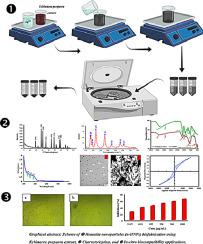Surfaces and Interfaces ( IF 5.7 ) Pub Date : 2021-04-02 , DOI: 10.1016/j.surfin.2021.101113 Mostafa F. Al-Hakkani , Gamal A. Gouda , Sedky H.A. Hassan , Adham M. Nagiub

|
Ferric oxide “Alpha Hematite” nanoparticles (α-HNPs) were phyto-fabricated using ferrous sulfate heptahydrate solution and Echinacea purpurea liquid extract that acts as a reducing, capping, and stabilizing agent in a ratio (1:2) at temperature 70°C, 1500 rpm for 5 hours. E. purpurea is a rich source of polyphenolic, flavonoid compounds that have a high anti-oxidant ability. The reaction conditions of the synthesis of nanoparticles were optimized. Physicochemical; optical, electrical, magnetic, and morphological properties of the as-biofabricated α-HNPs were characterized using a diversity of analytical techniques. Results confirmed that E. purpurea extract mediated the α-HNPs are at high, pure crystalline nature, spherical with a rhombohedral crystallographic system at the nanoscale with mean crystallite size 25.1 nm using XRD, and average particle size 26.4 nm by TEM. A large surface area of 28.01 g/m2 and less aggregation monodispersed phase with crystallinity index 1.1 was be achieved. Moderate anti-inflammatory activity “IC50 466.1 μg/mL” was achieved via α-HNPs against diclofenac potassium as a model for the NSAIDs. The E. purpurea mediated α-HNPs hold cogent anti-bacterial activity against different species of Gram-positive & Gram-negative bacteria. Cytotoxicity of the E. purpurea liquid extract and α-HNPs against MCF7, HepG2, and HCT116 cell lines were being studied. The α-HNPs demonstrated a better cytotoxic impact than the E. purpurea; where IC50 for E. purpurea were found to be 633.7, 620.2, and 879.8 µg/mL for MCF7, HepG2, and HCT116 cell lines respectively; while in the case of α-HNPs treatment IC50 were reduced into 132.0, 189.0, and 377.0 µg/mL for the same cell lines respectively.
中文翻译:

紫锥菊紫杉醇介导的赤铁矿纳米粒子(α- HNPs)的制备,表征,理化性质及其体外生物相容性评价
使用七水合硫酸亚铁溶液和紫锥菊(Echinacea purpurea)液体提取物以比例(1:2)在70°C的温度下对三氧化二铁“α赤铁矿”纳米粒子(α -HNP)进行了植物制造。,以1500 rpm的转速运转5小时。紫癜大肠杆菌(E. purpurea)是具有高抗氧化能力的多酚类黄酮化合物的丰富来源。优化了合成纳米颗粒的反应条件。理化; 使用多种分析技术对生物制备的α -HNP的光学,电,磁和形态学特性进行了表征。结果证实紫癜大肠埃希菌提取物介导了α-HNP具有高纯度的纯晶体性质,在纳米级具有球形菱面体晶体学系统,使用XRD的平均晶粒尺寸为25.1 nm,通过TEM的平均粒径为26.4 nm。获得了28.01 g / m 2的大表面积和结晶度指数为1.1的较少聚集的单分散相。中等抗炎活性“IC 50 466.1 μ克/毫升”达到通过α-的HNP对双氯芬酸钾作为NSAIDs的一个模型。该E.菊介导的α-的HNP嫌弃不同种类的革兰氏阳性和革兰氏阴性菌的有说服力的抗菌活性。紫癜液体提取物和α-的细胞毒性正在研究针对MCF7,HepG2和HCT116细胞系的HNP。所述α-的HNP证明比更好的细胞毒性的影响E.菊; 其中IC 50为E.菊被发现是633.7,620.2,和879.8 μ微克/毫升以分别MCF7,HepG2细胞,和HCT116细胞系; 而对于α- HNPs处理,同一细胞系的IC 50分别降至132.0、189.0和377.0 µg / mL。











































 京公网安备 11010802027423号
京公网安备 11010802027423号